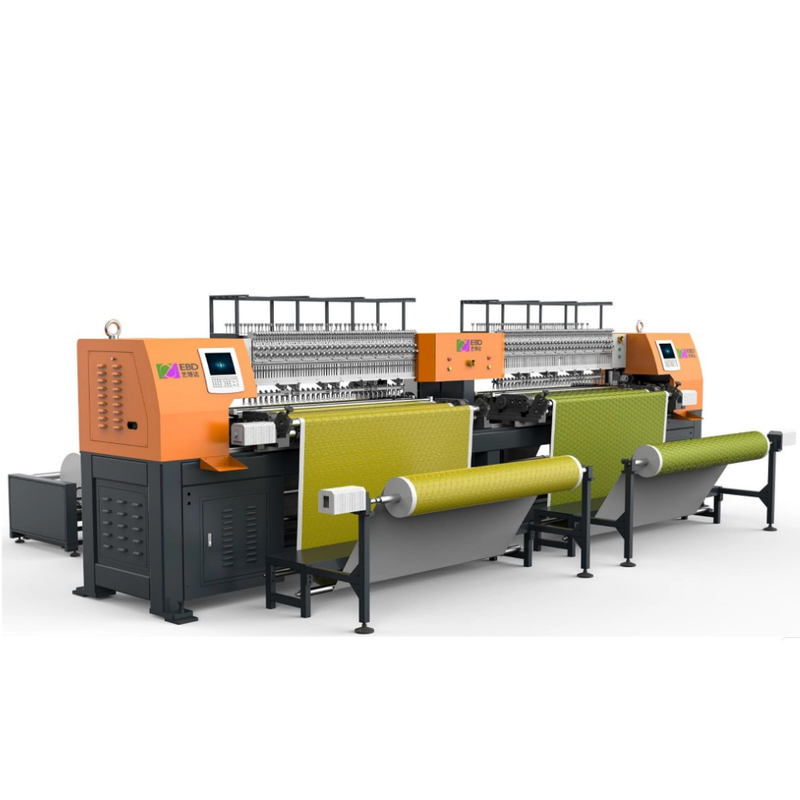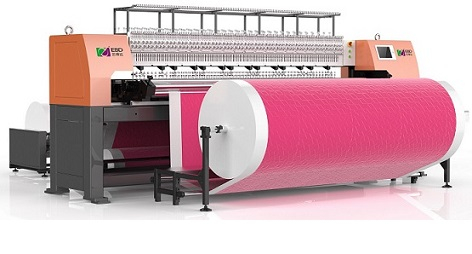Views: 0 Author: Site Editor Publish Time: 2025-11-11 Origin: Site








Are you looking to boost your quilting production? Industrial quilting machines are transforming the textile industry. These powerful machines differ significantly from traditional models, enhancing efficiency and quality.
In this post, you'll learn about the key benefits of using industrial quilting machines. We'll explore their impact on various industries, from home textiles to automotive applications.
Industrial quilting machines are game changers in textile production. They significantly boost efficiency through various automation features that reduce the need for manual labor.
● High-Speed Stitching: These machines can achieve impressive speeds, often stitching between 1,500 and 3,000 stitches per minute. In contrast, traditional machines typically operate at only 300 to 800 stitches per minute.
Machine Type | Typical Speed (Stitches Per Minute) |
Industrial Quilting Machine | 1,500 - 3,000 |
Traditional Quilting Machine | 300 - 800 |
This difference translates into higher output. For instance, a textile company recently reported a 50% increase in production after switching to an industrial quilting machine. This capability allows businesses to scale operations efficiently and respond quickly to market demands.
Cost savings are another compelling reason to invest in industrial quilting machines. Here’s how they help:
1. Lower Labor Costs: Fewer operators are needed, which leads to significant reductions in payroll expenses. A large-scale operation noted savings of thousands of dollars annually after automating their quilting process.
2. Material Savings: Precision stitching minimizes fabric waste. This efficiency ensures that nearly every inch of fabric is utilized effectively, maximizing material investments.
3. Energy Efficiency: These machines consume less energy compared to traditional quilting machines. This reduction translates into long-term savings on utility bills, benefiting both the environment and the bottom line.
Quality is crucial in the textile industry, and industrial quilting machines excel in delivering consistent results. Here’s what sets them apart:
● Precision and Accuracy: Computer-controlled systems enhance stitching accuracy, ensuring high-quality outputs that meet customer expectations. This consistency boosts brand reputation, as consumers increasingly seek reliable products.
● Durability: Products made with industrial quilting machines tend to be more durable. For example, outdoor gear crafted using these advanced techniques withstands harsh conditions far better than those made with traditional methods.
● Quality Control Features: Modern machines integrate automatic defect detection systems. These systems monitor stitching quality in real time, ensuring only the best products reach the market.
Another standout feature of industrial quilting machines is their versatility. They can process a wide variety of fabrics, including:
● Cotton
● Synthetic materials
● Leather
This adaptability makes them suitable for numerous industries, from fashion to automotive.
Customization Options: Manufacturers can easily create unique patterns and designs tailored to customer needs. Many machines come equipped with user-friendly software for integrating custom designs, making it simple to bring creative visions to life.
Customized Machine Configurations: Businesses can adjust machine specifications to fit specific production requirements. This modularity enhances productivity, allowing manufacturers to adapt quickly to changing market demands.
The industrial quilting landscape is rapidly evolving. Here are some of the latest innovations:
● Automatic Thread Cutting: This feature reduces downtime and increases efficiency.
● Pattern Storage: Machines can save multiple designs, allowing for quick switches between projects.
● Multi-Head Designs: These allow for simultaneous stitching, significantly boosting output.
Integration with Other Technologies: Industrial quilting machines now work seamlessly with CAD software and automated cutting machines. This integration creates a fully streamlined production line.
Future Trends: Experts predict that advancements in automation and AI will revolutionize the industry. As these technologies develop, businesses will be better equipped to meet the demands of an ever-changing market landscape.

Industrial quilting machines are transforming various industries by enhancing production processes and improving product quality. Here are some key sectors where these machines make a significant impact:
In the home textiles sector, industrial quilting machines are widely used for creating bedding, cushions, and curtains. They enable manufacturers to produce high-quality quilts and covers efficiently. For example, a bedding company might use these machines to create intricate designs that appeal to modern consumers. The precision stitching ensures that every product is not only aesthetically pleasing but also durable, leading to increased customer satisfaction.
The automotive industry benefits immensely from industrial quilting machines, particularly in the production of seat covers and interior upholstery. These machines provide the ability to work with various materials, including leather and synthetic fabrics, allowing for customized designs that enhance the vehicle's interior. A notable example includes a manufacturer that streamlined its upholstery process, resulting in faster turnaround times and improved product quality.
Outdoor equipment manufacturers rely on industrial quilting machines for applications in tents, sleeping bags, and other gear. The durability and weather resistance of products made with these machines are crucial for outdoor enthusiasts. For instance, a company specializing in camping gear utilizes these machines to produce lightweight, yet robust sleeping bags, ensuring they withstand harsh conditions while maintaining comfort.
In the furniture industry, industrial quilting machines are essential for creating stylish sofas and decorative cushions. They allow for intricate designs and patterns that enhance the visual appeal of furniture pieces. A furniture maker reported using these machines to reduce production time while increasing the variety of designs available, leading to higher sales and customer interest.
Real-life examples illustrate the transformative power of industrial quilting machines across various companies.
● Company A: A bedding manufacturer implemented an industrial quilting machine and saw a 30% reduction in production time. They reported significant cost savings, allowing them to invest in new product lines.
● Company B: An automotive upholstery firm adopted these machines, resulting in a 40% improvement in product quality. Customer feedback highlighted the enhanced durability of their seat covers, which led to repeat business.
Company | Industry | Efficiency Improvement | Cost Savings | Quality Enhancement |
Company A | Home Textiles | 30% | Significant | High |
Company B | Automotive | 40% | Notable | Excellent |
Company C | Outdoor Equipment | 25% | Considerable | Superior |
When considering industrial quilting machines, brands like Yiboda, ABM, Gmax, and Richpeace stand out for their unique features and benefits.
● Yiboda: Known for its user-friendly interface and high-speed capabilities, Yiboda machines are ideal for large-scale operations.
● ABM: Offers advanced automation features that streamline production processes, making them suitable for diverse applications.
● Gmax: Focuses on versatility, allowing users to switch between different fabric types seamlessly.
● Richpeace: Renowned for its durability and reliability, Richpeace machines are often favored by companies requiring consistent performance.
These brands provide various options tailored to different production needs, enabling businesses to choose the best fit for their operations.

Selecting the right industrial quilting machine involves several critical factors. Understanding these considerations can help you make an informed decision that aligns with your production needs.
When evaluating industrial quilting machines, there are specific features that stand out as essential for effective performance.
One of the primary factors to consider is the balance between stitching speed and quality. A machine's speed, typically measured in stitches per minute (SPM), directly impacts production efficiency. However, it’s crucial to ensure that increased speed does not compromise the quality of the stitching. For instance, a machine that offers 1,800 SPM might be ideal for high-volume production, but if the stitch quality suffers, it can lead to higher defect rates and rework costs.
Stitching Speed | Quality Impact | Recommended Use |
1,200 SPM | High | Small to medium production |
1,800 SPM | Moderate | High-volume production |
2,500 SPM | Variable | Specialized applications |
User-friendly interfaces are vital, especially for operators who may not have extensive training. Look for machines that offer intuitive controls and clear instructions. Additionally, consider the maintenance requirements; machines that are easy to maintain and service will reduce downtime and keep production running smoothly. For example, a machine with quick-change features for needles and threads can save valuable time during setup.
The ability to customize a machine for specific needs is another important factor. Different projects may require unique stitching patterns or fabric types. Machines that allow for easy adjustments or have programmable settings can enhance versatility. This adaptability means you can respond quickly to changing customer demands or new product lines without needing to invest in additional equipment.
Before making a purchase, verify essential technical specifications. Key parameters to consider include:
● Stitches Per Minute (SPM): Higher numbers indicate faster production.
● Motor Power: A more powerful motor can handle thicker fabrics without strain.
● Fabric Thickness Support: Ensure the machine can accommodate the types of materials you plan to use.
Understanding the financial implications of purchasing an industrial quilting machine is crucial for any business.
When budgeting, consider both the initial purchase price and the long-term savings. While a higher upfront cost may seem daunting, investing in a quality machine can lead to significant savings over time. For example, machines that require less maintenance and have lower operational costs can yield a better return on investment (ROI) in the long run.
Cost Category | Estimated Amount |
Initial Purchase Price | $10,000 - $50,000 |
Annual Maintenance Costs | $500 - $2,000 |
Operational Savings (per year) | $2,000 - $10,000 |
When it comes to acquiring an industrial quilting machine, businesses often face the choice between leasing and buying.
● Leasing: This option allows for lower initial costs and can be beneficial for businesses that need flexibility. It also enables companies to upgrade to newer models more frequently.
● Buying: While this requires a larger upfront investment, it leads to ownership and potentially lower long-term costs.
Finally, performing a cost-benefit analysis can help evaluate the ROI from using industrial quilting machines. Consider factors such as increased production capacity, reduced labor costs, and improved product quality. By quantifying these benefits, businesses can justify their investment and make strategic decisions that align with their operational goals.
Industrial quilting machines offer numerous benefits. They enhance efficiency, reduce production costs, and improve product quality.
Investing in these machines can lead to significant long-term advantages for businesses.
We encourage companies to explore these benefits further.
Consider contacting manufacturers for personalized consultations to find the right machine for your needs.
A: The average cost ranges from $10,000 to $50,000, depending on features and capabilities.
A: Typically, it takes a few days to a couple of weeks to become proficient.
A: Regular maintenance includes cleaning, oiling, and checking for worn parts.
A: Yes, they can accommodate various fabrics, including thick materials and specialized textiles.
A: Energy consumption varies by model, but most are designed for efficient operation.